非谓语动词--分词的用法
非谓语动词用法总结

• • • • • •
• • • • • • • • • • • •
既能加to do 有能加doing做宾语的动词,意 思基本没有区别的: Like to do /like doing sth Start to do /start doing Hate to do sth /hate doing sth Love to do /love doing sth 既能加to do 有能加doing做宾语的动词,意 思基本有区别的: Stop to do Stop doing forget to do Forget doing Remember to do Remember doing Regret to do Regret doing Mean to do 打算做某事 Mean doing 意味着做某事 Can’t help to do 不能帮忙做某事 Can’t help doing 忍不住做某事
• • • • • • •
Doing 动名词一般作主语,宾语,表语,定语 1)作主语 Listening to teachers in class is very important. 动名词作主语时,谓语动词用单数。 2)动名词作宾语(放在介词或者是及物动词后面) 只能加doing做宾语的及物动词和动词短语 Enjoy ,finish, miss(错过),excuse(原谅),admit(承 认),avoid(避免),imagine(想象),appreciate (感 激,欣赏),escape(逃避),postpone 推迟,dislike (不喜欢), • Give up , put off, put up with(容忍,忍受) ,get down to (开始认真做某事),set about (着手),make contributions to ,contribute to, look forward to, devote …to .., object to(反对), be opposed to, pay attention to
非谓语动词——分词
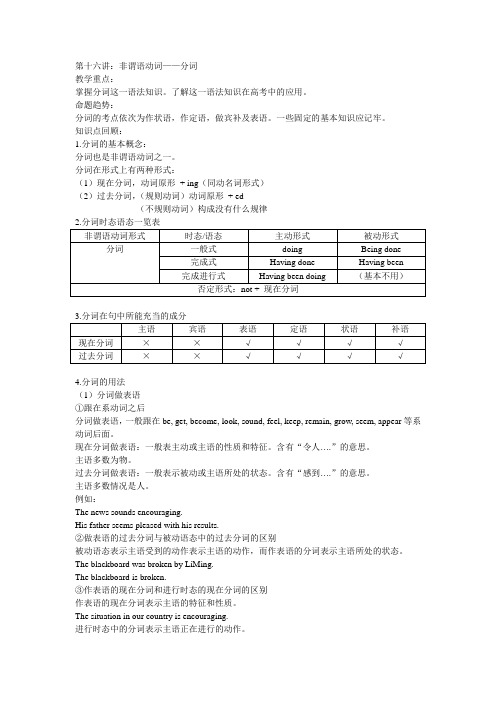
第十六讲:非谓语动词——分词教学重点:掌握分词这一语法知识。
了解这一语法知识在高考中的应用。
命题趋势:分词的考点依次为作状语,作定语,做宾补及表语。
一些固定的基本知识应记牢。
知识点回顾:1.分词的基本概念:分词也是非谓语动词之一。
分词在形式上有两种形式:(1)现在分词,动词原形+ ing(同动名词形式)(2)过去分词,(规则动词)动词原形+ ed(不规则动词)构成没有什么规律4.分词的用法(1)分词做表语①跟在系动词之后分词做表语,一般跟在be, get, become, look, sound, feel, keep, remain, grow, seem, appear等系动词后面。
现在分词做表语:一般表主动或主语的性质和特征。
含有“令人….”的意思。
主语多数为物。
过去分词做表语:一般表示被动或主语所处的状态。
含有“感到….”的意思。
主语多数情况是人。
例如:The news sounds encouraging.His father seems pleased with his results.②做表语的过去分词与被动语态中的过去分词的区别被动语态表示主语受到的动作表示主语的动作,而作表语的分词表示主语所处的状态。
The blackboard was broken by LiMing.The blackboard is broken.③作表语的现在分词和进行时态的现在分词的区别作表语的现在分词表示主语的特征和性质。
The situation in our country is encouraging.进行时态中的分词表示主语正在进行的动作。
The situation in our country is encouraging the people.另外,在分词作表语的结构中,可以用其它系动词来代替be,但在进行结构中,则不可以。
因为进行时的句型必须是be + doing。
The news is surprising. = The news sounds surprising.④分词、动名词和不定式作表语的区别分词作表语:主要是表示主语的特点和所处的状态主语和表语的位置不可以互换。
非谓语动词-分词的用法.ppt.ppt
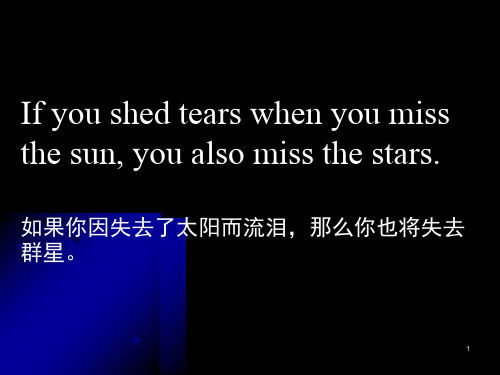
把下列划线部分改写成分词短语, 并说明其功能
B.过去分词作状语学与练
1.When she was asked why she did it, she began to cry.
*Asked why she did it, she began to cry.
*过去分词短语作时间状语
*从句的动词用的是被动语态
让步状 语从句
分词作状语功能表
表示的范围
相当的状语从句
1.时间
2.原因
3.条件
4.让步
5.方式/伴随
时间状语从句
原因 状 语从句
条件 状 语从句
让步状 语从句
没有合适的状 语从句
A.现在分词作状语学与练
把划线部分改写成分词短语 并说明其功能
1.1.When they saw their teacher, the students stood up.
Having finished their homework, they went home.
*现在分词短语作( )
*Having finished their homework表现的动作在went home( ),故用分词的( ).
时间状语
之前
完成式
2.Because he was ill, he couldn’t go to school.
=Once it is used, the car will never be sold again.
*When heated, water turns into steam.
=When water is heated, water turns into steam.
5.The teacher stood there and he was surrounded(包围) by many students.
非谓语动词-分词

4. Being used by me now, the bike can’t be lent to you.
(由于)正在被我使用, 这辆自行车不能借给你。
Being struck by the heavy storm, they felt helpless. (因为)正被猛烈的暴风雨袭击,他们感到很无助。
Ⅱ 分词的用法
一.作表语
1. 过去分词作表语,表示主语所处的状态
The window is broken. 窗户破了。 The train is crowded. 火车很拥挤。 She is excited. 她很激动。
2. 现在分词表示主语的特征或属性,通常物作主语, “令人...”
过去分词表示主语的状态,通常人作主语, “感到...”
a drowning man 快要淹死的 a drowned man 已经淹死的
falling leaves fallen leaves
正在飘落的树叶 落叶
2. 分词作后置定语
分词 doing
分词和被修饰的名词 的主被关系
主动关系
being done
被动关系
分词在时间上的意义
表示正在进行或 习惯性动作
完成式
(not ) having (not ) having been
done
done
过去分词: 一般只有一种形式:done
Ⅰ 分词的时态和语态
一. 现在分词的时态变化:
1) 现在分词的一般式:
表示动作与谓语动词同时发生,或几乎同 时发生。
当(他)正在路上走的时候,他发现了一支钢笔。
Walking along the street, he found a pen. (同时发生 )
分词非谓语动词讲解
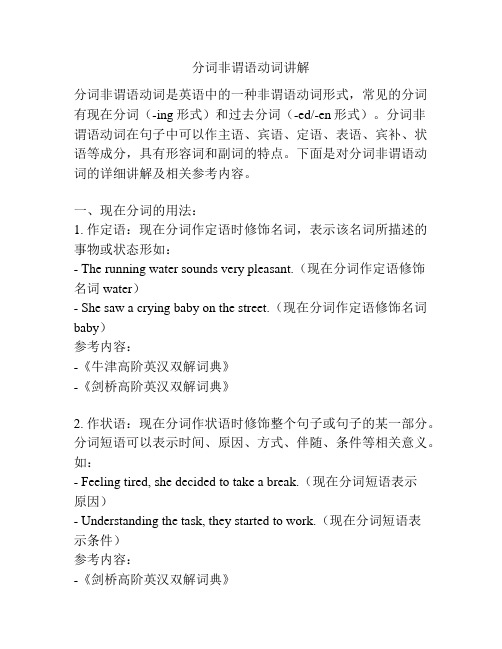
分词非谓语动词讲解分词非谓语动词是英语中的一种非谓语动词形式,常见的分词有现在分词(-ing形式)和过去分词(-ed/-en形式)。
分词非谓语动词在句子中可以作主语、宾语、定语、表语、宾补、状语等成分,具有形容词和副词的特点。
下面是对分词非谓语动词的详细讲解及相关参考内容。
一、现在分词的用法:1. 作定语:现在分词作定语时修饰名词,表示该名词所描述的事物或状态形如:- The running water sounds very pleasant.(现在分词作定语修饰名词water)- She saw a crying baby on the street.(现在分词作定语修饰名词baby)参考内容:-《牛津高阶英汉双解词典》-《剑桥高阶英汉双解词典》2. 作状语:现在分词作状语时修饰整个句子或句子的某一部分。
分词短语可以表示时间、原因、方式、伴随、条件等相关意义。
如:- Feeling tired, she decided to take a break.(现在分词短语表示原因)- Understanding the task, they started to work.(现在分词短语表示条件)参考内容:-《剑桥高阶英汉双解词典》-《英汉大词典》二、过去分词的用法:1. 作定语:过去分词在句中作定语时,修饰名词,表示该名词被动、完成或被描述的状态,如:- The broken vase needs to be repaired.(过去分词作定语修饰名词vase)- The information provided is accurate.(过去分词作定语修饰名词information)参考内容:-《朗文当代高级英语辞典》-《剑桥国际英语高级词典》2. 作表语:过去分词可以作表语,表示主语的状态或特征,如:- He is interested in the books written by the famous author.(过去分词作表语修饰主语)- The glass is broken.(过去分词作表语修饰主语)参考内容:-《剑桥高阶英汉双解词典》-《牛津高阶英汉双解词典》三、分词作宾补的用法:分词非谓语动词可以作及物动词的宾语补足语,表示被动、完成的意义,如:- She found the door locked.(分词作宾补修饰宾语door)- They heard the news announced on the radio.(分词作宾补修饰宾语news)参考内容:-《韦氏英语用法词典》-《剑桥高阶英汉双解词典》综上所述,分词非谓语动词的用法主要包括现在分词作定语、状语,过去分词作定语、表语和宾补等。
非谓语动词之分词

ii) 分词短语作定语时,总是放在它所修饰的名词之 后
Most of the workers working in this shop are young people.
在这个商店工作的大多是年轻人。
This is the factory set up by the students themselves.
用法: 在句中可作表语、定语、补语和状语。
1) 作定语:
i)
单独的分词作定语时,一般放在所修饰的名词之前,但 有时也放后。例如:
They are attacking players.他们是进攻性运动员。 The reporter asked an embarrassing question. 记者提了一个令人尴尬的问题。 His job was to take care of the wounded soldier. 他的任务就是照料这个伤兵。 但是有时候单个分词作后置定语。如: We have supplied all the tools needed.
表原因:
Being a student, I must study hard. 因为是学生,我必须努力学习。 Tony ate the cake up, not wanting to share it with Carl. 托尼把蛋糕吃完了,因为不想和卡尔分享。 This textbook, written in simple English, is suitable for beginners. 这本课本,因为是用简单英语写成,所以很适 合初学者。
表结果
The old man fell off the bicycle, hurting his head. 老人从自行车上摔了下来,伤了头。 His car was caught in a traffic jam, thus causing the delay. 他的车遇到了交通堵塞,结果导致延误。
语法要点回顾非谓语动词的用法总结
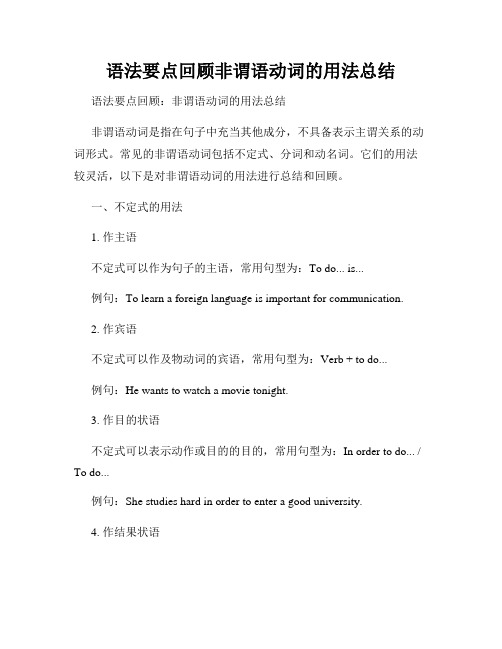
语法要点回顾非谓语动词的用法总结语法要点回顾:非谓语动词的用法总结非谓语动词是指在句子中充当其他成分,不具备表示主谓关系的动词形式。
常见的非谓语动词包括不定式、分词和动名词。
它们的用法较灵活,以下是对非谓语动词的用法进行总结和回顾。
一、不定式的用法1. 作主语不定式可以作为句子的主语,常用句型为:To do... is...例句:To learn a foreign language is important for communication.2. 作宾语不定式可以作及物动词的宾语,常用句型为:Verb + to do...例句:He wants to watch a movie tonight.3. 作目的状语不定式可以表示动作或目的的目的,常用句型为:In order to do... / To do...例句:She studies hard in order to enter a good university.4. 作结果状语不定式可以表示动作或目的的结果,常用句型为:So as to do... / In order to do...例句:He saved money so as to buy a new car.5. 作定语不定式可以修饰名词,常用句型为:Noun + to do...例句:She needs a person to help her with the project.6. 作状语不定式可以作时间、原因、方式、条件、结果等方面的状语,常用句型为:(To do...)…例句:- We woke up early to catch the train.- I came here today to see you.二、分词的用法1. 现在分词作定语现在分词可以修饰名词,常用句型为:Noun + V-ing...例句:The running water sounds very pleasant.2. 过去分词作定语过去分词可以修饰名词,常用句型为:Noun + V-ed...例句:The broken vase needs to be replaced.3. 分词短语作状语分词和分词短语可以作时间、原因、方式、条件、结果等方面的状语。
分词非谓语动词用法总结
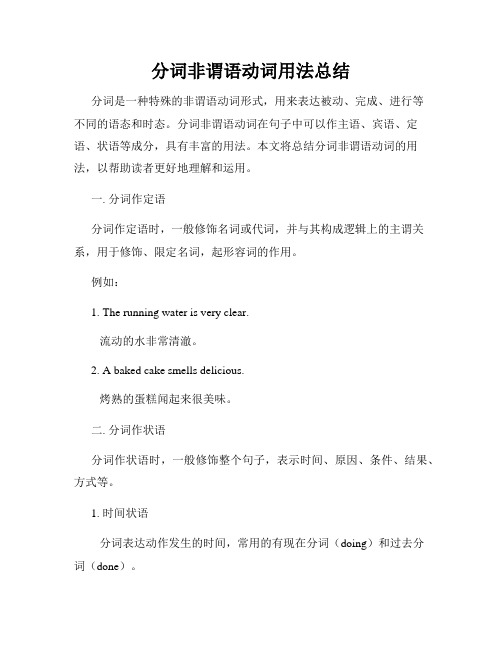
分词非谓语动词用法总结分词是一种特殊的非谓语动词形式,用来表达被动、完成、进行等不同的语态和时态。
分词非谓语动词在句子中可以作主语、宾语、定语、状语等成分,具有丰富的用法。
本文将总结分词非谓语动词的用法,以帮助读者更好地理解和运用。
一. 分词作定语分词作定语时,一般修饰名词或代词,并与其构成逻辑上的主谓关系,用于修饰、限定名词,起形容词的作用。
例如:1. The running water is very clear.流动的水非常清澈。
2. A baked cake smells delicious.烤熟的蛋糕闻起来很美味。
二. 分词作状语分词作状语时,一般修饰整个句子,表示时间、原因、条件、结果、方式等。
1. 时间状语分词表达动作发生的时间,常用的有现在分词(doing)和过去分词(done)。
例如:Cooking dinner, she accidentally burned her hand.她在做晚饭时不小心烧伤了手。
Exhausted from the long journey, they went straight to bed.他们疲惫不堪地进行了漫长的旅行,直接上床睡觉。
2. 原因状语分词表达动作的原因,常用过去分词形式。
例如:Surprised by the sudden news, he couldn't say a word.受突如其来的消息的惊愕,他说不出话来。
Lost in thoughts, she didn't notice the time passing by.沉浸在思考中,她没有注意到时间的流逝。
3. 条件状语分词表达动作的条件,也常用过去分词形式。
例如:Given the right opportunities, anyone can succeed.给予合适的机会,任何人都能成功。
Without proper training, it's difficult to master a new skill.没有适当的培训,要掌握一项新技能是很困难的。
分词非谓语动词详解

分词非谓语动词详解分词是动词的一种非谓语形式,在句子中起到形容词或副词的作用。
它可以被用作定语、表语、宾语补足语等,用于修饰名词或代词,增强句子的表达力。
分词在英语中有两种形式:现在分词和过去分词,它们分别以-ing和-ed结尾。
本文将详细解释分词的用法和句子中的具体应用。
一、现在分词现在分词是由动词的基本形式加上-ing构成,表示正在进行或者被动作的状态或行为。
1. 作定语现在分词可以用作定语,修饰名词或代词,增加句子的描述性和细节。
例如:- A smiling child greeted us at the door.(一个微笑的孩子在门口迎接我们。
)- The running water sounds soothing.(奔流的水声听起来很舒缓。
)2. 作表语现在分词也可以作为表语,说明主语的特征或状态。
例如:- The book is interesting.(这本书很有趣。
)- The situation is becoming complicated.(情况变得复杂。
)3. 作状语现在分词可以用作状语,表示伴随、原因、时间、方式等。
例如:- Lying on the grass, she enjoyed the sunshine.(躺在草地上,她享受着阳光。
)- Knowing the answer, he confidently raised his hand.(他知道答案,自信地举起了手。
)二、过去分词过去分词是由动词的过去式形式或加上-ed(部分不规则动词除外)构成,常用来表示被动语态或完成状态。
1. 作定语过去分词可以用作定语,描述被修饰名词或代词的状态。
例如:- The broken glass should be handled with care.(破碎的玻璃应该小心处理。
)- The lost key has been found.(丢失的钥匙已经找到。
)过去分词也可以作为表语,说明主语的特征或状态。
非谓语动词分词的用法总结

非谓语动词分词的用法总结一、非谓语动词分词的基本概念及形式非谓语动词分词是英语中的一种特殊用法,常用来表达被动、完成、主动等不同含义。
在句子中作为定语、状语或补语,并且有时可以替代从句。
它的形式通常为“过去分词”或“现在分词”,具体使用取决于上下文和句子结构。
1. 过去分词过去分词通常由动词原形后加上-ed或-d构成,如:played, taken, finished等。
它可以表示被动意义,也可以表示稍微延续的状态或完成的行为。
2. 现在分词现在分词通常由动词原形后加-ing构成,如:playing, taking, working等。
它可以表示主动进行的行为,同时也具有形容词性质。
二、非谓语动词分词作定语非谓语动词分词可以用作定语来修饰名词,起到进一步说明、限定名次的作用。
1. 过去分词作定语过去分词作为定语时,通常修饰被其所描述的名次,如:broken heart (破碎的心) ,cooked rice (煮熟的米饭)等。
它可以表示被动或完成的状态。
2. 现在分词作定语现在分词作为定语时,通常修饰与之相关的名次,并且描述正在进行或主动发生的行为,如:a running river (奔流的河流) ,a barking dog (叫唤的狗)等。
三、非谓语动词分词作状语非谓语动词分词可以用作状语来修饰句子、从句或名词短语,起到表示时间、原因、方式、条件等不同功能的作用。
1. 过去分词作状语过去分词作为状语时,可以表示原因、结果、条件、时间等。
例如:Having finished his homework, he went out to play. (完成了家庭作业后,他出去玩了)2. 现在分词作状语现在分词作为状语时,可以表达同时进行、原因、方式等含义。
例如:Walking slowly, she enjoyed the beautiful scenery. (慢慢地走着,她欣赏美丽的风景)四、非谓语动词分词作补语非谓语动词分词还可以用来充当及物动词的宾补或形容词的补足语,起到补充说明、进一步描述的作用。
非谓语动词现在分词和过去分词的用法

非谓语动词(现在分词/过去分词的具体用法)Step1:分词的语法意义:(1)分词是非谓语动词,不可以单独作谓语.(2)它具有动词、形容词、副词的特征.A:当它具备动词特征时可有自己的宾语,也可带状语构成分词短语.B:当它具备形容词的特点时,可在句中作定语、宾语补足语和状语,还可以构成独立结构.C:当它具有副词特征时,可在句中作状语,也可构成独立结构.Step2:分类:分词按语法功能可分为现在分词和过去分词两种.Step3:构成:现在分词v+-ing(即v-ing形式);过去分词:V+-ed(即v-ed形式).一,分词作定语的用法.(一)现在分词作定语的用法.特点:(1)单个现在分词作定语时,一般放在所修饰词的后面.(2)若是现在分词短语作定语时,则放在它所修饰词的后面.(3)现在分词作定语,意思表示“正在----的”或“即将-----的”或“令人------的”.(4)与所修饰的名词之间是主动关系,或者表是表示正在进行的动作.E g: The student raised a confusing question.(表示:令人费解/困惑的)主语及物动词定语宾语译文:这个学生提出一个令人困惑的问题.E g: The retiring teacher walked into the classroom.(表示:即将退休的)定语译文:这位即将退休的老师步入教室.E g: The aging father found it hard to solve this tough problem. (表示:年华正在老去的)定语译文:这位日渐年迈的父亲发现很难解决这个棘手的问题.E g: The man talking to a stranger loudly is our English teacher.(表示:主动和正在进行)现在分词作后置定语译文:正在和一位谋生人大声交谈的那个人是我们的英语老师.(二)过去分词作定语的用法.特点:(1)单个过去分词作定语时,一般放在所修饰词的后面.(2)若是过去分词短语作定语时,则放在它所修饰词的后面.(3)过去分词作定语,意思表示“感到----的”或“受到-----的”.(4)与所修饰的名词之间是被动关系,或者表示:已经完成的动作.E g: The retired soldier passed away last year. (表示:已经退休的或者动作已经完成)定语译文:那个退役的军人上个月去世了.E g: The wounded soldier was sent to the hospital immediately. (表示:受伤的或者动定语经完成).译文:那位受伤的士兵被立刻送往医院.E g: Give me some boiled water to drink. (表示:已经煮开过的或者动作已经完成)定语译文:给我弄点白开水喝.练习:He is sweeping (falling; fallen) leaves in the (falling; fallen) rain.译文:他在雨中扫落叶.二,分词作表语的用法.(一)现在分词作表语的用法.特点:单个现在分词作表语时,多表示主语所具有的特征.一般放在系动词be/become/look/sound/smell/remain/seem/appear等后面.作表语的分词均为形容词.可以译成:“-----------的”.E g: The English speech contest is really exciting.(表示:令人兴奋的)表语译文:这次英语演讲比赛很令人兴奋.E g: The naughty baby is very tiring.(表示:令人累的)表语译文:这个调皮的孩子真是累人.E g: The food smells so inviting. (表示:令人诱惑的)表语译文:这食物闻起来很诱人.E g: This once-in-a-blue-moon experience is really thrilling. (表示:令人刺激的)译文:这次难得的经历真扣人心弦.(二)过去分词作表语的用法.特点:单个过去分词作表语时,多表示主语所处的状态.一般放在系动词be/ become/look/sound/smell/remain/seem/appear等后面.作表语的分词均为形容词.可以译成:“-----------的”.E g: I was bored by her endless bragging. (表示:感到枯燥、厌倦的).译文:她不停地吹嘘,我烦透了.E g: I’m really interested in making a speech in English in public. (表示:感到有趣的)译文:我对在公共场合用英文演讲非常感兴趣.E g: I felt confused about this matter. (表示:感到费解、迷惑的)译文:我对这件事情很费解.总结:并非所有的分词均可当形容词对待.有些分词不能翻译成“--------的”.Killed:不能译成“感到杀的”Killing:不能译成“令人杀的”Writing: 不能译成“令人写的”Written: 不能译成“感到写的”此类分词,只能置于be动词之后,不可置于连系动词(become/look/sound/smell/remain/seem/appear)等后面,不可视为是形容词,而视为动词的进行时或被动语态.E g: He was murdered last night. (表示:一般过去式的被动语态)译文:他昨晚被谋杀了.E g: I can’t believe you didn’t have a written contract.译文:我简直不敢相信,你居然没有一份书面合同.三,分词作宾语补足语的用法.(一)现在分词作宾语补足语的用法.特点:现在分词作宾语补足语时常用在感官动词和使役动词之后,现在分词一般强调动作正在进行,主动,与物有关.方法:(1)宾补的动词若为及物动词,后面一定接宾语,共同作宾补.(2)宾补的动词为不及物动词,一律用现在分词.(3)宾语与宾补之间为主动关系.(4)宾补的动作在逻辑上是由宾语来完成的.E g: I heard some girls gossiping about you.宾语补足语译文:我听到一些女孩子在说你的闲话.E g: I found him killing cockroaches宾语补足语译文:我发现他正在杀蟑螂.E g: I saw him coming out of the office just now.宾语补足语译文:我刚才看见他正在从办公室出来.(二)过去分词作宾语补足语的用法.特点:现在分词作宾语补足语时常用在感官动词和使役动词之后,过去分词一般强调被动,完成,与人有关.方法:(1)宾补的动词为及物动词,后面不可接宾语(2.)宾语与宾补之间为被动关系,宾补与前面的宾语构成动宾关系.(3)宾补的动作不是由宾语自身完成.E g: I found the cockroaches killed.(过去分词充当宾语补足语)译文:我发现那些蟑螂被人杀了.E g: I had my wallet robbed in the street this morning. (过去分词充当宾语补足语)译文:今天早上在街上我的钱包被人抢了.(三)由介词with引导的复合结构中,分词作宾语补足语的用法.特点:置于句首或句尾,常用来修饰句中的主语,以表示主语所处的状况,通常为大动作附带小动作时,大动作以句子的动词表示,而小动作则使用with复合结构.(1)with +宾语+宾补(过去分词充当).特点:宾语与宾补之间表示被动和完成.E g: He stood there with his arms folded.译文:他双臂交叉站在那里.E g: He sat there with his eyes closed.译文:他双眼闭着坐在那儿.(2)with +宾语+宾补(现在分词充当).特点:宾语与宾补之间表示主动和正在进行.E g: He talked to me with his legs shaking译文:他和我说话时两腿发抖.E g: A: Come on, Please give me some ideas about the project.B: Sorry. With so much work filling my mind, I almost break down.(3)with +宾语+宾补(动词不定式充当).特点:宾语与宾补之间表示将要发生或没有完成.E g: With a lot of difficult problems to settle, the manager felt worried all the time.译文:由于很多的难题没有得到解决,经理一直很担忧.(4)with +宾语+宾补(介词短语充当).特点:表示宾语所处的状态.E g: He talked to me with a pipe in his mouth.译文:他和我说话时嘴里叼着烟斗.四,分词作状语的用法.(一)现在分词作状语的用法.特点:(1)现在分词短语作状语时刻表示原因、方式、伴随、结果、或条件等.此时它的逻辑主语应与句子的主语保持一致.(2)现在分词一般式,若现在分词短语表示的动作与谓语表示的动作同时发生,或者紧接发生,也可在该短语前加上when或while; (3)现在分词的完成时,若现在分词短语表示的动作在谓语表示的动作之前发生.(4)若现在分词短语的逻辑主语(即句子的主语)发出该动作,则就是主动语态.(5)若现在分词短语的逻辑主语(句子的主语)承受了该动作,那么就用它的被动式.E g:We often provide our children with toys, footballs or basketballs, thinking that all children like these things.(现在分词在句中作伴随状语,而且句子的主语是thinking的执行者).译文:我们考虑到孩子们都喜欢这些东西,通常给孩子提供玩具;足球和篮球.E g: Daddy didn’t mind what we were doing, as long as we were together, having fun. (现在分词在句中作伴随状语,而且句子的主语we是having的执行者).译文:只要我们能在一起共享乐趣,爸爸不会介意我们在做什么.E g: The storm left, having caused a lot of damage to this area.(说明:分词的逻辑主语为the storm,故用现在分词表示主动,因为是造成破坏之后离开的,所以用现在完成时态,在句中作时间状语从句)可以改写为:After it had caused a lot of damage to this area, the storm left.E g:Having been separated from other continents for millions of years, Australia has many plants and animals not found in any other country in the world.(说明:separate from 与主句主语有被动的含义,并且先于主句谓语动词,因此用现在分词完成时的被动语态)E g: Oil prices have risen by 32percent since the start of the year, reaching a recor d$57.65 a barrel on April 4.(现在分词在句中作伴随状语)译文:自从今年开始油价已经上涨了32﹪,在4月份达到每桶$57.65这个记录.E g: The manager, having made it clear to us that he didn’t agree with us, left the meeting room.(现在分词的完成时态表示动作发生在主句的动作之前).E g: Whenever he was asked why he was late for class, he would answer careless, always saying the same thing.译文:无论什么时候他被问到为什么他会上课迟到,他总是粗心地答复,说着同样的话.E g: He is a student at Oxford University, studying for a degree in computer science.(现在分词在句中作伴随状语)E g: He was busy writing a story, only stopping once in a while to smoke a cigarette. (现在分词在句中作伴随状语)译文:他那时忙于写一个故事,只是偶尔停下来抽支烟.E g:Having been shown around the Water Cube, we were then taken to see the Bird’s Nest for the 2008 Olympic Games.译文:我们参观了水立方后,又被带去参观了为2008年奥运会准备的鸟巢.E g: Not realizing that he was in great danger, Eric walked deeper into the forest. (主语Eric与realize 构成主动关系,因此用realizing,v-ing形式前加not表示否定)练习题:1,in the queue for half an hour, the old man suddenly realized he had left the cheque in the car.A: Waiting B: To wait C: Having waited D: To have waited2, in the fields on a March afternoon, he could feel the warmth of spring.A: To walk B: Walking C: Walked D: Having walked3, their hats into the air, the fans of the winning team let out loud shouts of victory.A: To throw B: Thrown C: Throwing B: Being thrown4, We had an anxious couple of weeks for the results of the experiment.A: wait B: to be waiting C: waited D: waiting.5, that she was going off to sleep , I asked if she’s like that little doll on her bed.A: Seeing B: To see C: See D: Seen.6, The wild flowers looked like a soft orange blanket the desert.A: Covering B: Covered C: Cover D: To cover.(二)过去分词作状语的用法.特点:(1)过去分词短语作状语修饰谓语动词,说明其发生的情况,可以放在句首其强调作用,也可放在句中、句末,它的逻辑主语须与句子的主语保持一致.(2)过去分词一般表示动作已完成,只有一般式.(3)过去分词表示被动和完成E g:Dressed in a white uniform, he looks more like a cook than a doctor.说明:当状语从句的主语和主句主语相一致且谓语包含动词be的某种形式时,可省略从句的主语以及动词be. 恢复原句:When he is dressed in a white uniform, -----------.译文:穿着白色的制服,他看上去更像是个厨师而不像医生.E g: When offered help, one often says “ Thank you.” Or “It’s kind of you.”译文:当被提供了帮助时,人们常说:“谢谢”或“你真好”.E g: Faced with so much trouble, we failed to complete the task on time.说明:be faced with 表示:“面临,面对.”作原因状语.译文:由于面临很多的困难,我们未能按时完成这项工作.E g: Blamed for the breakdown of the school computer network, Alice was in low spirits. (作原因状语).练习题:1,No matter how frequently , the works of Beethoven still attract people all over the world.A: Performed B: Performing C: to be performed D: being performed2,The flowers his friend gave him will die unless every day.A: watered B: watering C: water D: to water3, by a greater demand of vegetables , farmers have built more green houses.A: Driven B: Being driven C : To drive D: Having driven4, To learn English well, we should find opportunities to hear English as much as we can.A: speak B: speaking C: spoken D: to speak5, It is one of the funniest things on the internet so far this year.A: finding B: being found C: to find D: found(三)分词结构-----动词变化1,若一句中有两个动词同时存在,彼此一定要有连接词相连.E g: He studied very hard but failed the exam.2, 若两个动词没有连接词相连,注意下列变化原则.(1) 若两个动词所代表的动作时同时发生时,第二个动词一定要变成现在分词;若该动词是be动词,变成现在分词being 之后要省略.E g: He sat in the corner reading books.(他一面坐在角落,一面看书,动作同时发生,因此read应该变成现在分词)译文:他坐在角落看书.E g: Don’t sit there doing nothing. Come and help me with this table.译文:别坐那儿无所事事,过来帮助我收拾一下桌子.E g: He came home was tired.第一步:变成:He came home being tired.第二步:变成:He came home tired.(说明:他一面回家,一面感到累,故came与was tired同时发生.由于was是be动词,变成being之后应给予省略)译文:他回到家感到很累.E g: He left young and came back old.译文:他少小离家老大回.E g: We are born equal.译文:我们生而平等.(2)若两个动词所代表的动作并非同时发生,而是有先后次序时,第二个动词就要变成“to+动词原形)形成的不定式短语,作目的状语.E g: He stood up to smoke a cigarette.译文:他站起来抽烟.E g: He rushed here to tell me the story.译文:他赶到这里来告诉我这个故事.(3)若有两个动词有逗号隔开,而无连接词时,就不必考虑动词所代表的动作先后发生的次序,第二个动词一定要变成现在分词.E g: He left home at six in the morning, arriving here about four in the afternoon.译文:他早上6点离开家,约下午4点抵达此地.E g: He ran away quickly, looking as if something terrible had happened.译文:他很快的跑开了,看起来好像发生了什么可怕的事.(四)分词结构-----单句化简法.两个句子在一起,若无连接词相连时,往往第一个句子要化简,变成分词短语.法则如下:(1)两句的主语相同时,被化简的句子的主语要删除,若主语不同时要保留.(2)之后的动词要变成现在分词.(3)若该动词为be动词时,变成现在分词being之后,可给予省略,但亦可不予省略,以强调“因为------”的意思.E g: He has nothing to do, he feels bored.改正:化简第一个句子第一步:删除相同的主语he第二步:其后动词has变成现在分词having.最简化为:Having nothing to do , he feels bored.译文:他没有事情可做,所以觉得无聊.E g: He was sick of studying, he ran away from home.改正:化简第一个句子第一步:删除相同的主语he第二步:其后动词was变成现在分词being,然后给予省略.最简化为:Sick of studying, he ran away from home.译文:他厌倦学习,所以离家出走了.E g: The sun set, the cowboys rode back to the ranch.改正:化简第一个句子第一步:因为两个句子的主语不同,故要保留.第二步:其后动词set变成现在分词setting.最简化为:The sun setting, the cowboys rode back to the ranch.译文:夕阳西下,牛仔们刺马回到牧场(五)使用单句化简法时应注意事项.(1)变成否定分词结构时,not要置于分词前.E g:Not satisfied with result, he decided to try again.译文:他不满意此结果,决定再试一次.(2)句中有助动词do/does/did时,可直接删除.E g: He didn’t intend to see her, he left early.-----Not intending to see her, he left early.译文:他不打算见她,便提前离开了.(3)句中有完成时助动词has /have/had要视为动词而变成现在分词having.E g: He had done the work, he felt very happy.--------having done the work , he left happy.译文:他做完了这个工作,觉得很高兴.E g: I have not seen her for ages, I miss her very much.-------Not having seen her for ages, I miss her very much.译文:好久没有见面了,我非常想念她.(4)主语不同时,所形成的分词短语,成为分词的独立主格结构.所谓分词的独立主格结构,就是独立修饰不同主语的分词结构.在句中只能做状语,表示条件;时间;原因;伴随情况.E g: This being the case, you’d better be more careful.(解释:this being the case原为this is the case,但如此一来,本句与you’d better be more careful 无连接词相连.故将第一个句子化简为分词短语.由于主语不同,故给予保留,之后的动词is变成现在分词being, being the case 独立修饰不同主语this,故称为分词的独立主格结构).译文:这样的话,你最好多加小心.E g: All things considered, I decided to major in business administration.译文:全盘考虑后,我决定主修企业管理.E g: All the work finished, you can go home.译文:所有工作都做完了,你可以回家了.E g: Weather permitting , we are going to have a picnic tomorrow.译文:若天气许可,我们明天就去野餐.(六)分词短语------定语从句化简法.1,在限定性定语从句中、(即关系代词之前无逗号)中,若关系代词作主语时,可化简成分词短语,法则如下:(1)删除关系代词(2)其后动词变成现在分词.(3)若该动词为be动词,变成现在分词being之后,可给予省略.E g: The man who is talking to Mary over there is my father.第一步:将who删除第二步:将who之后的is变成现在分词being第三步:再将being省略.上句可简化成:-----------The man talking to Mary over there is my father.译文:那边那位正在和玛丽说话的男士是我爸爸.2,在非限制性的定语从句中(即关系代词之前有逗号)通常不得化简为分词短语.E g: I like Tom, who is talking to Mary.-------不能变成I like Tom, talking to Mary.3, 不过在非限制性的定语从句结构为“关系代词+be+名词”时,则仍可化简,从而形成同位语.E g: John, who is a good friend of mine, studies hard.------John, a good friend of mine , studies hard.译文:约翰,我的一个好朋友,学习很用功.(七)分词短语------状语从句化简法.Once; when; while; if ;unless; though等六个连接词所引导的状语从句中,若主语与主句中的主语相同时,亦可化简为分词结构,法则与单句化简完全相同.注意:once; if; unless所引导的状语从句若化简为分词短语,多限于“主语+be+分词/形容词”的结构;而when; while; though则不限于此.E g: If I am free, I’ll go with you.-------If free,I’ll go with you.译文:如果有空,我将和你一起去.E g: Though he was seriously injured, he was not at all daunted.----- Though seriously injured, he was not at all daunted.译文:虽然受伤很严重,他一点都不畏惧.E g: Once I am available, I’ll let you know the result.----- O nce available, I’ll let you know the result.译文:一旦我有空,我会告诉你结果的.E g: Once I have money, I’ll buy a new car.------不能转化为Once having money, I’ll buy a new car.(八)少数现在分词可当成介词使用.(1)including 包含/包括=inclusive of ;(2)excluding =exclusive of除外;(3)considering 考虑;(4)regarding关于;(5)concerning=about=on关于E g: Considering his performance, he can be a good teacher.译文:从他的表现来看,他可以当个好老师.E g: He wrote an article regarding environment pollution.译文:他写了一篇有关环境污染的文章.(九)独立分词短语的使用.特点:某些独立分词短语有副词的功能,通常置于句首,修饰整个句子.常见的分词短语有:generally speaking(一般来说); judging from(从----判断); frankly speaking(坦率地说); considering everything(把一切考虑在内); strictly speaking(严格地说); talking of (谈到/谈及); according to(根据); seeing that+从句----------(既然);given that+从句---------(考虑到).E g:Generally speaking, the more expensive the camera, the better its quality.E g:Strictly speaking, he is not good enough.E g: Judging from his appearance, he seems to be rich.E g: Talking of the devil, he will appear.E g:According to John, the fire broke out at ten in the morning.E g:Seeing that you have no time, I’ll have Peter replac e you.E g: Given that you had very little help, I think you did very well.(十)与使役动词有关的重要分词短语的句子.1,I started the ball rolling. 我给那件事开个头.2,The news set my heart throbbing.这个消息使我心悸不已3, I am sorry to have kept you waiting.我很抱歉让你久等了.4, I couldn’t make myself understood. 我无法让别人听懂我的话. 5, I had my shoes repaired.我把我的鞋拿去修好了.6, He got a new suit made.他订做了一套西服.7, You should leave it unsaid.你应该别提这件事情.8, I like my eggs half boiled.我喜欢吃煮的半熟的鸡蛋.9, I had my watch stolen.我的表被偷了.。
英语语法总结:非谓语动词之分词
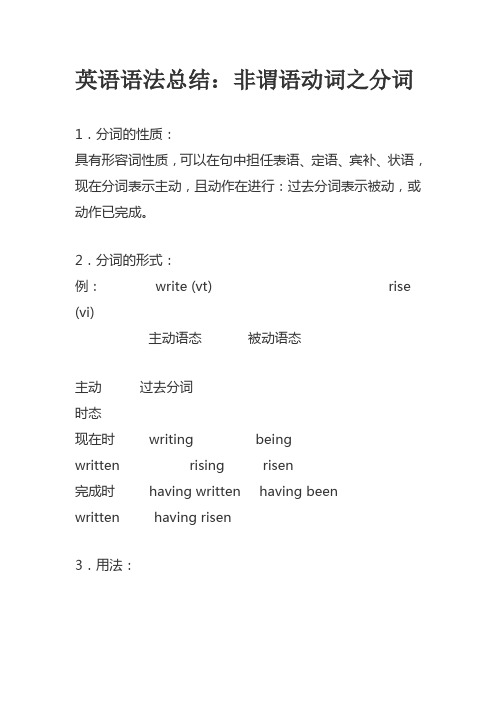
英语语法总结:非谓语动词之分词1.分词的性质:具有形容词性质,可以在句中担任表语、定语、宾补、状语,现在分词表示主动,且动作在进行:过去分词表示被动,或动作已完成。
2.分词的形式:例:write (vt) rise (vi)主动语态被动语态主动过去分词时态现在时writing beingwritten rising risen完成时having written having beenwritten having risen3.用法:(1)定语分词置于被修饰名词前分词短语于置于被修饰名词后a sleeping baby = a baby who is sleepinga running dog = a dog which is runninga broken glass = a glass which is brokena beaten team = a team which is beaten(beaten 是被打败的意思)(2)表语:The book is interesting.He is interested in the book.The news is exciting.He feels excited.(3)宾语补足语:When I woke up, I found my mother sitting besideme.I'd like to have this package weighed.掌握精髓:动词不定式作宾语表示动作的全过程,而现在分词作宾补表示动作正在进行;过去分词表示被动概念。
(4)状语:(以下例句值得一背!)①If you turn to the left, you'll find the station.→Turning to the left, you'll find the station.②As I didn't receive her letter, I called her up by telephone.→Not receiving her letter, I called her up by telephone.③While I was walking to school yesterday morning, I met a friend.→Walking to school yesterday morning, I met a friend.④When she was asked it she had any bad habit, she answered that she was a heavy smoker.→Asked if she had any bad habit, she answered that she was a heavy smoker.你知道吗?注意:在运用此类句型时主语前后要保持一致。
非谓语动词-分词做状语的用法[课件]金点
![非谓语动词-分词做状语的用法[课件]金点](https://img.taocdn.com/s3/m/07ba3d2a7375a417866f8f91.png)
1. We lived in the house __________________ built by my uncles (我舅舅们修建的). taken 2. Any medicine ________(服用) without the advice of a doctor can cause trouble. 3. We spent two hours discussing the plan __________________ (她制定的). made by her 4. _____________ (开水) boiled water
Exercises:
1. Most of the people ___________________ invited to the party (被邀请参加宴会的) were famous scientists. learned easily 2. Lessons _____________ (易学 的)are soon forgotten. Easily-learned ** _____________ (易学的) lessons are soon forgotten. 3. The computer center opened/started _________________(开办) last week is popular with the students .
3. The road that joins the two villages is very wide.
= The road joining the two villages is very wide.
过去分词作定语
过去 分词作定语表示被动或完成,一个分词单词作定语往往放 在它所饰的词的前面, 但分词短语作定语则放在所修饰的词的 后面. 1. Look at the broken cup.
非谓语动词中分词用法

多表时间,原因,结果,伴随
Entering the house, I found the window broken.
PS: 若是Judging from/ by, talking of , 若是 generally speaking,做状语时主语不用一 做状语时主语不用一 致
Judging from what you say, he has done his best.
1.This news sounds ____. A. encouraging B. encouraged C. encourage D. to encourage 简析:首先,根据语法分析可知,待选部分在句中应作表语, 简析:首先,根据语法分析可知,待选部分在句中应作表语,因 在此句中用作连系动词; 为 sounds 在此句中用作连系动词;再根据 The news 对于动词 encourage 来说应是主动关系,即这个消息本身就鼓舞人心。因此, 来说应是主动关系,即这个消息本身就鼓舞人心。因此, 该题应选 。 该题应选A。 2. -How did Bob do in the exams this time? -Well, his father seems ____ with his results. A. pleasing B. please C. pleased D. to please 简析:首先, 根据语法分析可知, 待选部分在句中应作表语。 简析:首先 根据语法分析可知 待选部分在句中应作表语。因为 seems 在此句中用作连系动词 再根据 his father 对于动词 please 来 在此句中用作连系动词; 说应是被动关系, 即这个结果使他的父亲高兴; 换言之, 说应是被动关系 即这个结果使他的父亲高兴 换言之 他的父亲因 为受到这个结果的刺激而感到高兴。因此, 该题应选 。 为受到这个结果的刺激而感到高兴。因此 该题应选C。 3. -How did the audience receive the new play? -They got very ____. A . excite B . excited C . excitedly D . exciting 简析:该题应选 。测试他们被那出新戏所打动。 简析:该题应选B。测试他们被那出新戏所打动。
非谓语动词——分词

非谓语动词——分词第十六讲:非谓语动词——分词教学重点:本节课的教学重点是掌握分词这一语法知识,并了解这一语法知识在高考中的应用。
命题趋势:分词的考点主要有四个:作状语、作定语、做宾补及表语。
考生需要掌握固定的基本知识。
知识点回顾:1.分词的基本概念:分词是非谓语动词之一,形式上有两种形式:现在分词和过去分词。
现在分词的形式是动词原形+ing,过去分词的形式有规则动词的动词原形+ed和不规则动词的构成没有规律。
2.分词时态语态一览表:分词有一般式、完成式和完成进行式,分别对应不同的时态和语态。
3.分词在句中所能充当的成分:现在分词和过去分词在句中可以充当不同的成分,如主语、宾语、表语、定语、状语和补语等。
4.分词的用法:分词可以做表语,一般跟在系动词之后,如be、get、e、look、sound、feel、keep、remain、grow、seem、appear等系动词后面。
现在分词做表语表示主语的特征和性质,而过去分词做表语表示主语所处的状态。
作表语的分词与被动语态中的过去分词的区别在于前者表示主语所处的状态,而后者表示主语受到的动作。
同时,作表语的现在分词和进行时态的现在分词也有区别,前者表示主语的特征和性质,后者表示主语正在进行的动作。
例如:___ news ___.(新闻听起来令人鼓舞。
)His ___.(他的父亲似乎对他的成绩很满意。
)___ ___.(黑板被___打破了。
)___.(黑板破了。
)___.(我们国家的形势很令人鼓舞。
)___.(我们国家的形势正在鼓舞人民。
)The news is surprising。
It ___.分词、动名词和不定式作表语的区别:分词作表语主要表达主语的特点和状态,主语和表语位置不能交换。
动名词和不定式作表语则主要表达主语的具体内容,位置通常可以交换。
例如:___ ___。
这部电影让人失望。
___ with the film。
我们对这部电影感到失望。
非谓语动词分词

第十六讲:非谓语动词——分词教学重点:掌握分词这一语法知识;了解这一语法知识在高考中的应用;命题趋势:分词的考点依次为作状语,作定语,做宾补及表语;一些固定的基本知识应记牢;知识点回顾:1.分词的基本概念:分词也是非谓语动词之一;分词在形式上有两种形式:1现在分词,动词原形 + ing同动名词形式2过去分词,规则动词动词原形 + ed不规则动词构成没有什么规律2.分词时态语态一览表3.分词在句中所能充当的成分4.分词的用法1分词做表语①跟在系动词之后分词做表语,一般跟在be, get, become, look, sound, feel, keep, remain, grow, seem, appear等系动词后面;现在分词做表语:一般表主动或主语的性质和特征;含有“令人….”的意思;主语多数为物;过去分词做表语:一般表示被动或主语所处的状态;含有“感到….”的意思;主语多数情况是人;例如:The news sounds encouraging.His father seems pleased with his results.②做表语的过去分词与被动语态中的过去分词的区别被动语态表示主语受到的动作表示主语的动作,而作表语的分词表示主语所处的状态;The blackboard was broken by LiMing.The blackboard is broken.③作表语的现在分词和进行时态的现在分词的区别作表语的现在分词表示主语的特征和性质;The situation in our country is encouraging.进行时态中的分词表示主语正在进行的动作;The situation in our country is encouraging the people.另外,在分词作表语的结构中,可以用其它系动词来代替be,但在进行结构中,则不可以;因为进行时的句型必须是be + doing;The news is surprising. = The news sounds surprising.④分词、动名词和不定式作表语的区别分词作表语:主要是表示主语的特点和所处的状态主语和表语的位置不可以互换;动名词和不定式作表语:主要是表示主语的具体内容;主语和表语的位置常常可以互换;The film is disappointing.这部电影令人失望;We are disappointed with the film.我们对这部电影感到失望;My job is teaching English. = Teaching English is my job.Our aim is to enter the universities. = To enter the universities is our aim.2分词作定语一般来讲,和分词做表语一样,现在分词修饰事物,过去分词修饰人;When they heard the exciting news, they got excited. Then the excited people shouted and cheered.当他们听到这一激动人心的消息时,他们变得激动起来;然后这些激动的人们大声叫喊,欢呼;①何时用现在分词的被动语态形式如果一个及物动词作定语,既要表达进行意味,又要表达被动意味时,用此形式;The question being discussed is very important.= The question that is being discussed is very important.Do you know the boy being punished by our teacher= Do you know the boy who is being punished by our teacher如果指的是将来的动作就要用不定式的被动形式或定语从句来表示;②何时用过去分词作定语过去分词包含完成和被动意味,一般表示的动作是在谓语动词所表示的动作之前发生;This is a picture painted by my father.= This is a picture that was painted by my father.3分词作宾语补足语I heard someone calling me.I had a decayed tooth pulled off.我让大夫把我一颗蛀牙拔了;常用的动词有:感觉动词:hear, see, notice, watch, feel, find, leave使役动词:make, let, have, get, keep①现在分词和过去分词做宾补的区别现在分词:与句子的宾语是主动关系,它表示动作的进行;过去分词:与句子的宾语是被动关系,它表示动作的完成和结果;I heard someone calling me.someone calling me = someone is calling me.I heard my name called.my name called = my name was called.We found the snake eating the eggs.We found the eggs eaten by the snake.②过去分词在动词have, get两词后面作宾语时,常常表示这个动作不是由主语完成的,而是由别人完成的,还有一种情况就是表示这是主语的经历;You’d better have get the dangerous building pulled down.你最好叫人把这座危楼推倒了;How ofter do you have get your hair cut你每隔多久理一次发LiMing had his bike stolen.李明的自行车被偷了;是主语的一种经历,遭遇③重要的词组:make oneself donemake oneself understood = to make one’s meaning clear to othersmake oneself heardI can’t make myself understood because of my broken English.I didn’t make myself heard because a lot of people cried in the hall.④现在分词、过去分词和不定式作宾补的区别例如:Do you hear someone calling you现在分词= Someone is calling you, do you hearYes, I did. I heard him call me several times.不定式Oh, you mean you hear your name called several times.过去分词= Your name was called several times, do you hearWhen he was decorating his house, he got the bedroom painted first.过去分词作宾补当他装修他的房子时,他首先把卧室粉刷了;When he was decorating his house, he had some workers paint his bedroom first.不定式作宾补当他装修他的房子时,他首先让工人把卧室粉刷一新;In order to finish it, he had the workers painting his bedroom all the day and night.为了完成它,他让工人们从早一直干到晚;注意:<1>由省去to的不定式构成的符合宾语在变为被动语态时,要把原来省去的小品词to还原,但let这个词例外,被动语态时,to可还原,也可省略;I watched the boy cross the street. → The boy was watched to cross the street.The teacher let the students write the composition at class.→The students were let to write the composition at class.<2>have…do这一句型不可以变为被动式,而make…do和let…do则可以;The boss had Tom clean the room. → Tom was made to clean the room.√Tom was had to clean the room.×<3>find的用法find + 宾语 + doing 宾补√find + 宾语 + done 宾补√find + 宾语 + 不定式√He found a wallet lying on the ground.He found the city changed a lot.He found them change the city.×<4>seat和sit的用法Please be seated. = Please sit down.What surprised me most was to see some of the village people seated sitting on the benches at the end of room.最使我惊奇的是看见村民们坐在房后的长登上;此句中的seated不能写成seating,但可以写成sitting<5>如果有一系列动作作宾语时,一般用不定式,而不用现在分词;I saw her enter the room, sit in a chair, open a book and begin to read.我看见她走进房间,坐在一把椅子上打开一本书开始读起来了;4分词作状语分词和分词短语可以在句子中作状语来修饰谓语动词或整个句子,表示动作发生的时间、原因、条件、结果、让步或伴随等情况;但分词状语一般表示一个次要的动作;分词作状语时,一般都可以变为相应的状语从句或并列句;①分词作时间状语<1>分词所表示的动作一发生,谓语动词表示的动作立即发生,可以用分词短语作状语;分词位置:放在前面;可以译为:“当……的时候”可以换成:on + 动名词结构;常用的动词多是表示一个极短暂动作的动词,如hear, see, return, look, open, close, arrive, leave Hearing the bad news, they couldn’t help crying.= When they heard the bad news they couldn’t help crying.= On hearing the bad news, they couldn’t help crying.当听到这个不幸的消息时,他们情不自禁地哭了起来;<2>分词所表示的动作在进行过程中,谓语动作发生了,此时可以用分词短语作状语,但一般在它的前面加上when或while;分词位置:前后都可以;可以译为:“当……时”While playing the piano, she got very excited.= While she was playing the piano, she got very excited.<3>分词所表示的动作完成了之后,谓语动词所表示的动作才发生,用分词的完成形式作状语;分词位置:放在句子前面;可以译为:“在……之后”;可以换成:after + 动名词这一结构;Having turned off the radio, he began to go over his lessons.= After he had turned off the radio, he began to go over his lessons.= After turning off the radio, he began to go over his lessons.②分词作原因状语分词短语作原因状语时,相当于一个原因状语从句,同时也可以转变为一个原因状语从句,分词的完成形式也经常用来作原因状语;<1>分词所表示的动作和谓语动词所表示的动作同时发生或几乎同时发生时,用分词的一般形式;Forgetting his manners, he put his feet up on the desk.= As he forgot his manners, he put his feet up on the desk.忘掉了他的举止要文明了他把脚放在书桌上;Being so angry, he couldn’t go to sleep.= because he was so angry, he couldn’t go to sleep.因为太生气了,他不能入睡;<2>分词所表示的动作在谓语动词所表示的动作之前发生,用分词的完成式;Having been to the Great Wall many times, he didn’t go last week.= Because As he had been to the Great Wall many times, he didn’t go last week.因为他已经去过长城许多次了,上周他就没去;③分词作条件状语分词短语有时表示一种假设情况,相当于一个条件从句,这种情况下,有时在分词短语前加上of, unless是条件更明确;Given more attention, the trees could have grown better.= If they had been given more attention, the trees could have grown better.如果对这些树再多注意些,它们可能长得更好;④分词作让步状语分词短语作让步状语时,相当于一个让步状语从句,有时分词前可带连词although, whether, even if, even though;Although working from morning till night his father didn’t get enough food.= Although his father worked from morning till night he didn’t get enough food.虽然他父亲从早到晚的拼命干,但是他还是挣不够吃的;⑤表示方式或伴随情况分词短语表示方式或伴随情况是比较常用的,它用来说明动作发生的背景或情况;一般情况下,分词所表示的动作和谓语动词所表示的动作同时发生;他没有相应的状语从句可转换,但可以用并列句来转换;They came into the classroom, singing and laughing.= They sang and laughed and they came into the classroom.他们又唱又笑地走进教室;⑥分词作结果状语分词短语作结果状语时,通常放在句末,中间有逗号,有时为了突出结果,分词前带有thus.The bus was helped up by the snowstorm, thus causing the delay.= The bus was helped up by the snowsorm, so it caused the delay.⑦分词作状语和不定式作状语的区别分词和不定式虽然都可以当状语,但区别较大;不定式作状语:主要是作目的状语和结果状语,还有一些作原因状语;分词作状语:一般表示时间、原因、条件、让步、方式、伴随等情况用作目的和结果状语的时候不多I’m sorry to hear that.The doctor, not wishing to make her nervous, didn’t fully explain the seriousness of her condition.⑧分词作状语时需注意事项<1>分词短语作状语时,他的逻辑主语通常应是句子的主语,这一点需特别注意;Seen from the hill, the city is beautiful.句子的主语是the citySeeing from the hill, you can see the whole city.句子的主语是youSeeing from the hill, the city is beautiful.×<2>例外的情况被用作介词或连词的分词supposing 假设、设想 considering 认为including 包括 according to 按照granted 认为Supposing he won’t pass the exam, what should he doMany people including the old go to work without any pay on Sunday.According to his report, the situation is getting serious.独立成分Generally speaking…..一般说来Frankly speaking….坦白地说Judging from….根据…..来判断Considering…..考虑到…..5.独立主格前面讲到的分词短语作状语时,它的逻辑主语应该是句子的主语;但有时分词短语带有自己的主语;它们之间存在着逻辑上的主谓关系,这个逻辑上的主语一般由名词担任,在分词短语之前,我们称为独立主格;独立主格在句中作状语,可以表示时间、原因、条件和方式、伴随;Because it is Sunday, you needn’t go to school.→It being Sunday, you needn’t go to school.After all the officials had arrived, the meeting was declared open.→All the officials having arrived, the meeting was declared open.If weather permits, we’ll go to the Summer Palace.→Weather permitting, we’ll go to the Summer Palace.with的复合结构作独立主格表伴随时,既可用分词的独立结构,也可用with的复合结构;with + 名词代词+ 现在分词/ 过去分词/ 形容词/ 副词/ 不定式/ 介词短语。
非谓语全讲解之分词(无盲区版)
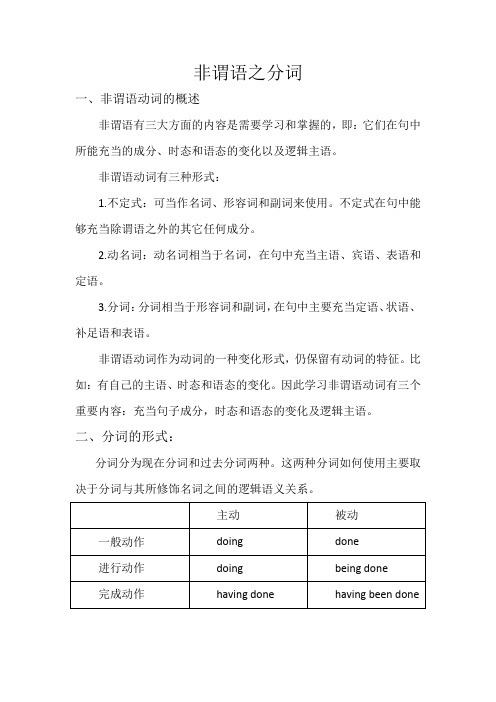
非谓语之分词一、非谓语动词的概述非谓语有三大方面的内容是需要学习和掌握的,即:它们在句中所能充当的成分、时态和语态的变化以及逻辑主语。
非谓语动词有三种形式:1.不定式:可当作名词、形容词和副词来使用。
不定式在句中能够充当除谓语之外的其它任何成分。
2.动名词:动名词相当于名词,在句中充当主语、宾语、表语和定语。
3.分词:分词相当于形容词和副词,在句中主要充当定语、状语、补足语和表语。
非谓语动词作为动词的一种变化形式,仍保留有动词的特征。
比如:有自己的主语、时态和语态的变化。
因此学习非谓语动词有三个重要内容:充当句子成分,时态和语态的变化及逻辑主语。
二、分词的形式:分词分为现在分词和过去分词两种。
这两种分词如何使用主要取决于分词与其所修饰名词之间的逻辑语义关系。
二、分词的意义:★现在分词的意义:从时态和语态两个角度分析分词的意义。
从语态看,现在分词表示主动意义,从时态看,现在分词表示进行的动作,相当于一个进行时态,同时还可以表示一般的动作,相当于一个一般时态。
1、主动,进行的动作。
例:①falling leaves 正在飘落的叶子②A sleeping dog 正在睡觉的狗③The man standing at the gate is my English teacher.站在门口的那个人是我们的英语老师。
④I like the girl dancing with that guy. 我喜欢正在和那个小伙子跳舞的女孩。
2、主动,一般的动作(表示某事物一贯特征)此用法表示的是所修饰名词的一种持久性的特点。
例:①flying fishes 飞鱼②A puzzling problem 令人迷惑的问题③They live in a room facing the south.他们住在一间朝南的屋子里。
=they live in a room that faces the south.★过去分词的意义:对于过去分词含义的理解,须区分及物动词和不及物动词。
非谓语动词-分词

Combine each pair of sentences using a participle and the words given in brackets. Make any other necessary changes. 1. Bears find a place on the side of a hill. They dig dens in the autumn. (find) ______________________________________ Having found a place on the side of a hill, bear dig ___________________________________ dens in the autumn. 2. Bears fill their dens with grass and leaves. They make a bed for themselves. (fill) ______________________________________ Filling their dens with grass and leaves, bears __________________________________ make a bed for themselves. 3. Bears gain up to 20 kg a week during summer and autumn. They hibernate. (gain) Having gained up to 20 kg a week during summer ___________________________ and autumn, bears hibernate.
).
分词在句子里 1)作定语,2)作表语, 3)作状语,4)作宾语补足语。
英语非谓语动词的用法总结

英语非谓语动词的用法总结英语非谓语动词的用法总结一、非谓语动词的定义非谓语动词是指不充当句子的谓语,而作为谓语动词的补语,或者修饰某一动词词组,从而起到补充完善句子的作用的动词形式的统称。
非谓语动词由不定式、动名词、分词和过去分词组成,简称 NPV (non-finite verb)。
二、非谓语动词的用法1. 不定式的用法(1)不定式作宾语不定式可以单独作宾语,在句子中必须接受动作,通常在句子中作宾语。
e.g.I want to go to the theater.(2)不定式作状语不定式还可以用作句子的状语,表示时间、原因、条件、方式等。
e.g.He spoke in a low voice to avoid being heard.2. 动名词的用法(1)动名词作宾语动名词可以做宾语,表示被动概念,表示被动的动作,或表示持续性动作。
e.g. She enjoyed listening to the music.(2)动名词作宾补动名词也可以用作宾补,即动名词后面跟介词或介词短语,是动词的宾补。
e.g. He gave up smoking last year.3. 分词的用法(1)分词作定语分词可以单独作定语,强调它所修饰的名词,表示被动的动作,或持续性的动作。
e.g. The injured man was taken to hospital at once.(2)分词作状语分词还可以作状语,用来表达一定的时间,原因,条件,方式等意义。
e.g. He wafts into the room, smiling.4. 过去分词的用法(1)过去分词作定语过去分词可以作定语,修饰某一名词,表示动作已经发生或被完成。
e.g. The broken window was mended yesterday.(2)过去分词作宾补过去分词也可以作宾补,表示动词的宾补,只能接受介词或介词短语作补语。
e.g. He stood there lost in thought.三、补充非谓语动词是英语中很重要的一部分,它的用法很多,可以使句子变得更加生动,更加有表达力。
非谓语动词分词的用法总结归纳
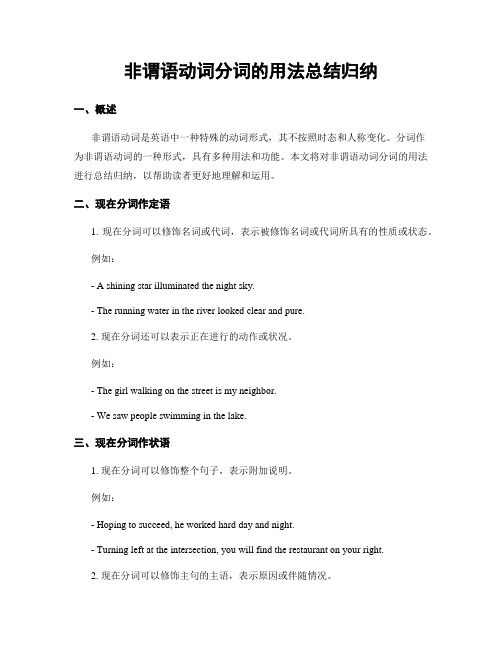
非谓语动词分词的用法总结归纳一、概述非谓语动词是英语中一种特殊的动词形式,其不按照时态和人称变化。
分词作为非谓语动词的一种形式,具有多种用法和功能。
本文将对非谓语动词分词的用法进行总结归纳,以帮助读者更好地理解和运用。
二、现在分词作定语1. 现在分词可以修饰名词或代词,表示被修饰名词或代词所具有的性质或状态。
例如:- A shining star illuminated the night sky.- The running water in the river looked clear and pure.2. 现在分词还可以表示正在进行的动作或状况。
例如:- The girl walking on the street is my neighbor.- We saw people swimming in the lake.三、现在分词作状语1. 现在分词可以修饰整个句子,表示附加说明。
例如:- Hoping to succeed, he worked hard day and night.- Turning left at the intersection, you will find the restaurant on your right.2. 现在分词可以修饰主句的主语,表示原因或伴随情况。
例如:- Being tired, she decided to take a break.- Having finished his homework, John went out for a walk.四、过去分词作定语1. 过去分词可以修饰名词或代词,表示被修饰名词或代词所受到的动作或影响。
例如:- The broken vase needs to be replaced.- I saw a damaged car on the side of the road.2. 过去分词还可以表示完成的动作或状态。
- 1、下载文档前请自行甄别文档内容的完整性,平台不提供额外的编辑、内容补充、找答案等附加服务。
- 2、"仅部分预览"的文档,不可在线预览部分如存在完整性等问题,可反馈申请退款(可完整预览的文档不适用该条件!)。
- 3、如文档侵犯您的权益,请联系客服反馈,我们会尽快为您处理(人工客服工作时间:9:00-18:30)。
*When heated, water turns into
steam.
=When water is heated, water turns
into steam.
.
5.The teacher stood there and he was surrounded(包围) by many students.
3.Moved deeply by what he said, so
he decided to help the poor girl.(×)
Because he was moved deeply by what he said, so he decided to help
the poor girl. (× )
*Defeated many times, they continued to fight. =Although defeated many times, they continued to fight. *过去分词短语作让步状语
*为使状语含义更加明确,有时在过去分 词前可加上适当连词.
*Once used, the car will never be sold again. (once “一旦……”)
Welcome our date!
.
If you shed tears when you miss the sun, you also miss the stars.
如果你因失去了太阳而流泪,那么你也将失去 群星。
.
Learn from One Love
flip 180 °180度转变 in mysterious ways 神奇的方式 without a trace 毫无痕迹 stay alive 保持活力,富有生机 this is far more than I can take
*过去分词短语作原因状语
.
3.If I am given more time, I’ll catch up with you.
*Given more time, I’ll catch up with you. *过去分词短语作条件状语
.
4.Although they had been defeated many times, they continued to fight.
*The teacher stood there surrounded by many students = Surrounded by many students, the teacher stood there.
*过去分词短语作伴随. 或方式状语
六.分词短语作状语须注意的问题:
练习: 判断正误并改正
*从句的动词用的是被动语态 *Asked why she did it, she began to cry.*过去分词短语作时间状语
*过去分词的动作由主. 语承受
2.Because he was moved by her words, he decided to help the poor boy. *Moved by her words, he decided to help the poor boy.
.
3.宾补 (使役动词+感官动词) 我看见那玻璃是破的. 我看见那男孩在把玻璃砸破.
I saw the glass broken . I saw the boy breaking the glass.
.
Grammar:
The Participle phrase used as Adverbial
.
分词作状语功能表
表示的范围
相当的状语从句
1.时间
时间状语从句
2.原因
原因 状 语从句
3.条件
条件 状 语从句
4.让步
让步状 语从句
5.方式/伴随
没有合适的状 语从句
.
A.现在分词作状语学与练
把划线部分改写成分词短语
并说明其功能 1.1.When they saw their teacher, the students stood up.
分 词短语作状语
.
Warming up
What clauses do you know?
1.When it rains, I’ll go to school by bus. 时间状语从句
2.As the day was fine, they decided to go on a trip. 原因状语从句
.
6.Although laughed at by others, he
didn’t give up his hope. (√)
=Although he was laughed at by others, he didn’t give up his hope.
.
Word extension
望夫石 夫去南洋探险(explore),要去寻找矿石 (ore),路途凶险不顾(ignore),妻子对他 爱慕(adore),日夜勤做家务(chore),汗 水弄粗毛孔(pore),而且(furthermore), 眼睛哭到疼痛(sore),望穿秋水在岸上 (ashore)。
.
3.If I go to the Great Wall tomorrow, would you like to come along? 条件 状 语从句
4.Although they did heavy work that day, they were all in high spirits.
让步状 语从句
1.Standing at the top of the hill, we can see Shiyan Town.(√) *现在分词所表示的动作由句子的主语发出
=When we stand at the top of the hill, we can see Shiyan Town.
.
2.Seen from the top of the hill, we
*The people (who are )building the house are my friends. *The house( which was )built last yearwill be pulled down. *The house( which is )being built will be a store.
现在分词 过去分词
(doing) ( done)
二.现在分词与过去分词区别:
语态 区别
现在分词 ( 主动 ) 过去分词 ( 被动 )
时态 区别 现在分词( 正在)进行
过去分词( 已经完成) .
复习练习一:根据汉语意思,用所给 动词的现在分词或过去分词填空 1.move
a moving film 动人的电影 (主动) a moved mother 受感动的妈妈 (被动)
cansee Shiyan Town. (×)
*Seen from the top of the hill, Shiyan Town can be seen clearly.
*过去分词表示的动作由句子的主语承受 =when it is seen from the top of the hill, Shiyan Town c.an be seen clearly.
*去掉so
*分词短语作状语,不能和连词连用.
.
4.When visited at night, you must make sure the visitor is really your
friend. (√)
=When you are visited, you must make sure the visitor is really your friend.
*现在分词短语作(时间状) 语 *Having finished their homework表现的动 作在went home(之前),故用分词的( ).
完成式 .
2.Because he was ill, he couldn’t go to school.
Being ill, he couldn’t go to school. *现在分词短语 作原因状语
.
5.The teacher came into the classroom, following by six (×) students.
The teacher came into the classroom, followed by six students.
*过去分词的动作由主语承受,而现在 分词的动作有主语发出.
这我根本无法接受 One love is all we need One love is that we need
.
Grammar
The Participle phrase used as Adverbial
分词 短 语 作 状 语
.
复习: 分 词 有关 用 法
一.分词可分为: (以do为例)
*Laughing and talking, the children came into the classroom.
*现在分词短语 作伴随或方式状语 *不可改成相应状语从句.
B.过去分词作状语学与练
把下列划线部分改写成分词短语, 并 说明其功能
1.When she was asked why she did it, she began to cry.
.
Wish you do your best in mid-exam!
.
此课件下载可自行编辑修改,此课件供参考! 部分内容来源于网络,如有侵权请与我联系删除!
